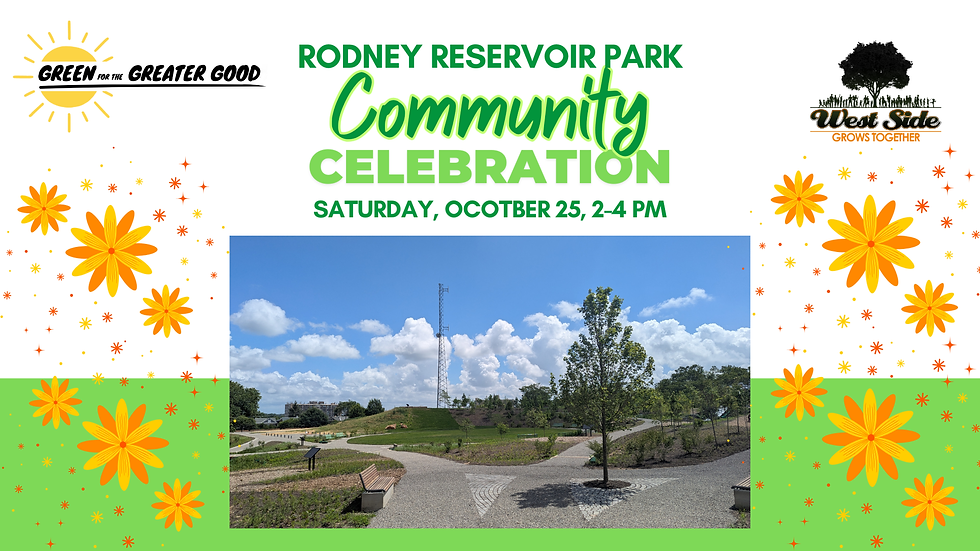Recap: Rodney Reservoir Community Design Charette
- Green for the Greater Good
- Jul 20, 2023
- 4 min read
Updated: Jul 24, 2023

Last month, Green for the Greater Good worked with partners to kick off the Rodney Reservoir Community Design Charette with a series of three sessions: in-person sessions at Saint Francis Hospital on June 13th and 22nd, and then a Zoom session on the 27th.
A charrette is a collaborative design process over multiple sessions that brings together diverse stakeholders to become acquainted with the historical and cultural importance of a particular site and to brainstorm and evaluate design concepts for a site's future use.
The goal of our community’s charrette was to bring neighbors, stakeholders and partners together with experts in landscape architecture and urban planning to facilitate our community’s thinking about what’s possible for a public park at the Rodney Reservoir site as well as to begin to take stock of our collective priorities and move toward a common vision for the site.
The turnout at the Rodney Reservoir Community Design Charrette was tremendous! More than 80 people took part across the series, including many neighbors living close to the reservoir, community members from partner organizations and City officials.
The charrette was facilitated by partners from the University of Delaware’s Living Lab, led by Anna Wik, RLA, ASLA and Dr. Nina David, professors in the Plant and Soil Sciences department and the Biden School of Public Policy and Administration, respectively, and a team of talented undergraduate fellows from the Landscape Architecture program. The collaboration was funded by a mini-grant from the Wilmington Partnership. We extend our thanks to this team and are excited to continue working with them in the fall!
Thanks also go to our friends at Saint Francis Hospital for hosting the in-person portion of the charrette.
Session-By-Session Recap
Session I
Session I included a presentation on the history of the site as a part of the City’s water infrastructure and public park.
Then, fellows presented examples of parks around the world, highlighting ways in which they incorporate elements that we might also like to see in a future park design. Elements included the adaptive reuse of water tanks like the one at the Rodney Reservoir, outdoor learning environments, urban agriculture, bio-diverse ecosystems and diverse and inclusive “third spaces.”
Participants engaged with aerial maps of the Rodney Reservoir and posters of these case studies and design elements–all for the purpose of stimulating discussion and brainstorming about the features residents would like to see in the future park.
Session II
At Session II, fellows presented three initial design ideas for the site based on community input at the previous session and other key parameters.
Once more, participants discussed and marked up plans with feedback–positive and negative–as well as questions and concerns and then circulated for more small and large group discussions.
Session III
For Session III, fellows once more compiled the community’s feedback and integrated those ideas to further develop two design concepts that combined elements from two of the first three designs that had been presented at the prior session. Again, attendees had the opportunity to ask questions about the designs and to make more suggestions.
Replay of Session III (Zoom) (Fast forward to 6-minute mark when session begins)
Key Learnings
The many community members who took part in the charrette expressed a strong preference for the entire site to be publicly accessible greenspace. Participants also stressed the desire to make this space interactive and engaging for residents of all ages.
There was also broad agreement that residents would like to build on current uses of the site as a community garden, apiary and wildlife habitat in future designs.
Participants also shared concerns about the lack of access to natural spaces in Wilmington neighborhoods like ours and expressed enthusiasm around seizing the unique opportunity to cultivate a natural space at the Rodney Reservoir.
Community members brainstormed around ways that recreational amenities, public art, a water feature or even a pet area might fit into a future design.
Many continued to voice appreciation for the elevation at the site, which gives visitors the sense of being outside the City. Working with visualizations created by the fellows, participants were able to think through the need to balance access, safety, usable space and elevation in future designs.
Finally, residents also recognized the reservoir site as a key resource for developing local solutions to offset the challenges that global warming and other environmental crises pose to community members in our dense urban neighborhood. Attendees discussed the importance of urban green space to mitigate increased temperatures caused by paved surfaces and to reduce water and air pollution. Comments and conversations also pointed to many ways the site could help our community become more resilient by contributing to public health and creating new educational opportunities for our children and youth.
Next Steps
The charrette showed that this community has a lot of great ideas for the future of the Rodney Reservoir site and wants not only to have a voice in its future design but to work together to realize its potential. The next post will talk about next steps for how we can all continue to be involved in efforts to develop a final design and help secure the resources to make it a reality.



This is an excellent overview of the Charrette process, and the great community engagement that Green for The Greater Good has facilitated (with partners) to advocate for the community design of a re-imagined, re-vitalized, re-designed, and re-opened (to the public) future Rodney Reservoir Park! Yeah! Excited for what comes next!!!